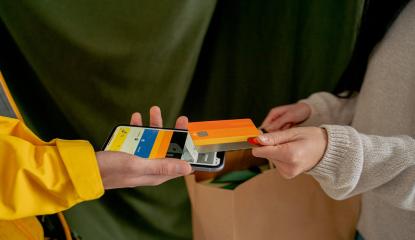
The Future of Payments: A Glimpse Into Tomorrow’s Transactions
The world of payments is evolving at an unprecedented pace. From cash to credit cards, and now to mobile wallets and cryptocurrencies, the way we pay for goods and services is constantly being reshaped by advancements in technology. The future of payments promises to be even more transformative, offering new methods of transactions that prioritize speed, security, and convenience.
In this blog post, we’ll explore some of the key trends that are shaping the future of payments, including digital currencies, biometric authentication, AI-driven payment solutions, and the rise of the Internet of Things (IoT) in financial transactions.
1. The Rise of Digital Currencies
Cryptocurrencies like Bitcoin, Ethereum, and stablecoins have been on the rise in recent years, and they are expected to play a larger role in the payments landscape. While some people still view digital currencies with skepticism, the continued development of blockchain technology has the potential to disrupt traditional financial systems.
Cryptocurrencies offer several advantages, such as faster cross-border payments, lower transaction fees, and greater transparency. Governments and central banks are also exploring Central Bank Digital Currencies (CBDCs) as a way to digitize their national currencies, which could have a profound impact on the future of money.
In the future, we could see more businesses accepting cryptocurrencies for payment, and consumers using digital wallets to pay for everything from coffee to cars. The decentralized nature of these currencies could offer new financial freedoms for individuals, especially in regions where traditional banking systems are less accessible.
2. Biometric Authentication: A Safer and More Convenient Way to Pay
As the digital payment ecosystem grows, security is a major concern. Passwords, PINs, and credit cards can all be vulnerable to fraud or theft. The solution to this problem may lie in biometric authentication, which uses unique physical traits—such as fingerprints, facial recognition, or iris scans—to verify a person’s identity.
Biometric payment systems are already being used in some parts of the world, allowing consumers to pay for goods and services with just a scan of their face or a touch of their finger. This technology is expected to become more widespread as consumer demand for seamless, secure transactions grows.
Not only do biometric payment solutions offer increased security, but they also enhance convenience by eliminating the need to remember complex passwords or carry physical cards. In the future, biometric authentication could become the standard for personal identification in payments, making fraud a thing of the past.
3. AI-Driven Payments: Personalizing the Payment Experience
Artificial Intelligence (AI) is transforming many industries, and the payments sector is no exception. AI is being used to personalize the payment experience, predict consumer behavior, and even prevent fraud. By analyzing data patterns, AI can help financial institutions and merchants offer more relevant products and services, making the payment process smoother and more tailored to individual preferences.
AI-driven payment solutions are also helping to detect fraudulent transactions in real time. Machine learning algorithms can analyze vast amounts of transaction data to spot unusual patterns, allowing financial institutions to flag potentially fraudulent activities before they cause harm.
As AI technology continues to evolve, we can expect smarter, more intuitive payment solutions that will make transactions faster, safer, and more personalized.
4. The Internet of Things (IoT): Payments Everywhere
The Internet of Things (IoT) is the network of connected devices that can communicate and exchange data. From smart speakers and wearables to refrigerators and cars, more and more objects are becoming connected to the internet. This opens up new possibilities for how we make payments.
Imagine being able to purchase groceries directly from your refrigerator, paying for a ride with your smartwatch, or even ordering your favorite coffee through your car’s dashboard. The future of payments could be truly seamless, with transactions happening automatically as we interact with the world around us.
IoT-based payments are already becoming a reality, with some companies developing smart devices that can facilitate transactions. As the number of connected devices grows, we’ll likely see a world where payments are integrated into almost every aspect of our daily lives.
5. Contactless and Mobile Payments: Speed and Convenience
Contactless payments, where you tap your card or smartphone to pay, are already widespread in many countries. This technology is expected to continue growing, driven by consumer demand for speed and convenience. With the rise of mobile wallets like Apple Pay, Google Wallet, and Samsung Pay, paying for goods and services is now as easy as tapping your phone on a payment terminal.
The future of contactless payments looks even more promising, as NFC (Near Field Communication) technology becomes more widespread. We can expect to see more businesses adopting contactless payment methods, reducing the need for physical cash or cards, and making transactions faster and more efficient.
As more people become comfortable with mobile payments, the trend towards a cashless society will continue to grow. In the future, your phone, smartwatch, or even a chip embedded in your body could replace your wallet altogether, offering the ultimate convenience.
6. Regulation and Privacy: A Balancing Act
As payments become increasingly digital, questions around regulation and privacy will be more important than ever. Governments and financial institutions will need to strike a balance between encouraging innovation and protecting consumers’ personal data.
The rise of digital currencies, AI-driven payments, and biometric authentication raises significant privacy concerns. Will our personal data be protected, or will it fall into the wrong hands? How will governments ensure that digital payments remain secure and equitable for all?
The future of payments will undoubtedly require new regulations to address these challenges. Privacy laws will need to evolve, and consumers will need to be more vigilant about how their personal data is used and shared.
7. The Impact of 5G on Payments
The advent of 5G technology will further accelerate the adoption of digital payments. With faster and more reliable internet connections, 5G will make it possible to complete transactions in real time, even in the most remote locations.
5G will also enhance the experience of mobile wallets and digital banking, making payments faster and more secure. As 5G networks continue to roll out, we can expect a world where mobile payments are instant, seamless, and ubiquitous.
Conclusion: A Cashless, Seamless Future
The future of payments is an exciting one, filled with innovation, convenience, and new opportunities. From digital currencies to biometric authentication, AI-driven personalization, and IoT-based transactions, we are moving towards a world where payments are faster, smarter, and more secure than ever before.
As these technologies continue to evolve, the way we interact with money will undergo a major transformation. The future of payments will not just be about buying and selling goods—it will be about creating seamless experiences, protecting personal data, and unlocking new financial possibilities for everyone.
So, get ready for a cashless, frictionless future, where making payments is as easy as unlocking your phone, and your financial transactions happen automatically in the background of your daily life. The future of payments is here, and it’s only going to get better.

Subscribe to our Newsletter
Resources and Insights
From Traditional to Digital: The Evolution of Business Payments
In this blog post, we will explore the journey of business payments, from traditional methods to the digital solutions that are shaping the future of commerce.
Read MoreHow Virtual Cards Enhance Security in Online Transactions
Virtual cards act as a secure shield for your online transactions by replacing your actual card details with temporary, unique credentials. They minimize the risk of data breaches and unauthorized access, offering enhanced privacy and control. With features like transaction limits and single-use functionality, virtual cards are transforming digital payments. Discover how they provide a smarter, safer way to shop online.
Read MoreScaling Your Business with Virtual Card Automation Tools
Discover how virtual card automation tools can empower your business to scale efficiently. From automated expense tracking to seamless integration with your accounting software, these tools streamline financial management. Virtual cards offer flexibility, enhanced control, and security, ensuring smooth scaling for startups and enterprises alike. Learn how to set up automated workflows, reduce manual errors, and optimize resource allocation, all while keeping your expenses in check. Explore the f...
Read More

